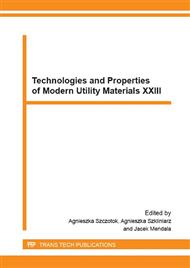[1]
G. Frommeyer, U. Brux, Microstructure and mechanical properties of High-strength Fe-Mn-Al-C light-weight TRIPLEX Steels, J. Iron Steel Res. Int. 77 (9-10) (2006) 627-633.
DOI: 10.1002/srin.200606440
Google Scholar
[2]
M. Jabłońska, A. Śmiglewicz, Analysis of substructure of high-Mn steels in the context of dominant stress mechanism, Defect Diffus. Forum 334-335 (2013) 177-181.
DOI: 10.4028/www.scientific.net/ddf.334-335.177
Google Scholar
[3]
M. Jabłońska, D. Kuc, G. Niewielski, B. Chmiela, Influence of the thermo-mechanical treatment on the properties and microstructure of high manganese austenitic-ferritic steel, Solid State Phenom. 226 (2015) 75-78.
DOI: 10.4028/www.scientific.net/ssp.226.75
Google Scholar
[4]
M. Jabłońska, A. Śmiglewicz, G. Niewielski, The effect of strain rate on the mechanical properties and microstructure of the high-Mn steel after dynamic deformation tests, Arch. Metall. Mater. 60/2 (2015) 577-580.
DOI: 10.1515/amm-2015-0176
Google Scholar
[5]
A. Niechajowicz, A. Tobota, Application of fly-wheel machine for sheet metal dynamic tensile tests, Arch. Civ. Mech. Eng. 8 (2008) 2, 129-137.
Google Scholar
[6]
M.B. Jabłońska, Mechanical properties and fractographic analysis of high manganese steels after dynamic deformation tests, Arch. Metall. Mater. 59 (2014) 3 1193-1197.
DOI: 10.2478/amm-2014-0207
Google Scholar
[7]
A. Śmiglewicz, M.B. Jabłońska, The effect of strain rate on the impact strength of the high-Mn steel, Metalurgija 54 (2015) 631-634.
Google Scholar
[8]
S. T Chiou, C. Chengb, W. S Lee, Strain rate effects on the mechanical properties of a Fe-Mn-Al alloy under dynamic impact deformations, Mat. Sci. Eng. A-Struct. 392 (2005) 156-162.
DOI: 10.1016/j.msea.2004.09.055
Google Scholar
[9]
Z. Gronostajski, S. Polak, Quasi-static and dynamic deformation of double-hat thin-walled element of vehicle controlled body crushing zones joined by clinching, Arch. Civ. Mech. Eng. 2 (2008) 57-66.
DOI: 10.1016/s1644-9665(12)60193-9
Google Scholar
[10]
M. Jabłońska, G. Niewielski, R. Kawalla, High Manganese TWIP Steel - Technological Plasticity and Selected Properties, Solid State Phenom. 212 (2014) 87÷90.
DOI: 10.4028/www.scientific.net/ssp.212.87
Google Scholar
[11]
D. Kuc, E. Hadasik, G. Niewielski, I. Schindler, E. Mazancová, S. Rusz, P. Kawulok, Structural and mechanical properties of laboratory rolled steels high-alloyed with manganese and aluminium, Arch. Civ. Mech. Eng. 12 (2012) 312-317.
DOI: 10.1016/j.acme.2012.06.008
Google Scholar
[12]
C. Froustey, M. Lambert, J.L. Charles, J.L. Latail-lade, Design of an Impact Loading Machine Based on a Flywheel Device: Application to the Fatigue Resistance of the High Rate Pre-straining Sensitivity of Aluminium Alloys, Exp. Mech. 47 (2007).
DOI: 10.1007/s11340-007-9082-4
Google Scholar
[13]
K.T. Park, S.W. Hwang, J.H. Ji, C.S. Lee, Static and Dynamic Deformation of Fully Austenitic High Mn Steels, Procedia Engineering 10 (2011) 1002-1006.
DOI: 10.1016/j.proeng.2011.04.165
Google Scholar
[14]
W. Moćko, Analysis of the impact of the frequency range of the tensometer bridge and projectile geometry on the results of the measurement by the split Hopkinson pressure bar method, Metrol. Meas. Syst. 20, 4 (2013) 555-564.
DOI: 10.2478/mms-2013-0047
Google Scholar
[15]
W. Moćko, J. Janiszewski, M. Grązka, Application of an extended Rusinek-Klepaczko constitutive model to predict the mechanical behavior of 6082-T6 aluminum under Taylor impact test conditions, J. Strain Analysis 48 (6) (2013) 364-375.
DOI: 10.1177/0309324713488885
Google Scholar
[16]
W. Moćko, L. Kruszka, Results of strain rate and temperature on mechanical properties of selected structural steels, Procedia Engineering 27 (2013) 789-797.
DOI: 10.1016/j.proeng.2013.04.100
Google Scholar
[17]
H. Kolsky, An Investigation of the Mechanical Properties of Materials at Very High Rates of Loading, Proc. Ph. Soc. 62B (1949) 647-700.
Google Scholar
[18]
U. Martin, D. Ehinger, L. Kruger, S. Martin, T. Mottitschka, C. Weigelt, C.G. Aneziris, M. Herrmann, Cellular Energy Absorbing TRIP-Steel/Mg-PSZ Composite: Honeycomb Structures Fabricated by a New Extrusion Powder Technology, Adv. Mater. Sci. Eng. (2010).
DOI: 10.1155/2010/269537
Google Scholar
[19]
G. Jacob, J.F. Fellers, S. Simunovic, J.M. Starbuck, Energy absorption in polymer composites for automotive crashworthiness, J. Compos. Mater. 36/7 (2002) 813-850.
DOI: 10.1177/0021998302036007164
Google Scholar


